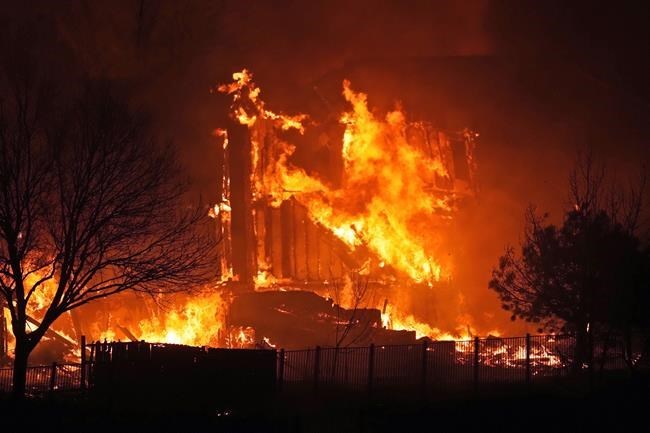DENVER (AP) — Embers from a smoldering scrap wood fire outside a home days earlier and a sparking power line caused a Colorado wildfire fanned by high winds that destroyed nearly 1,100 homes and left two people dead, authorities said Thursday.
The Dec. 30, 2021, blaze in heavily populated suburbs between Denver and Boulder caused $2 billion in damage, making it the most destructive in Colorado history. Two people were also found dead after what was known as the Marshall Fire.
The inferno erupted following months of drought amid a winter nearly devoid of snow and fed on bone-dry grassland surrounding fast-growing development in the area near the Rocky Mountain foothills. It spread rapidly in winds that gusted up to 100 mph (160 kph) in places.
There is no evidence to support criminal charges against anyone for the fire, Boulder County District Attorney Michael Dougherty said at a news conference.
The scrap wood fire — buried by residents Dec. 24 and OK’d by firefighters who stopped by that day to investigate — was one cause when the powerful winds uncovered the buried embers six days later, Sheriff Curtis Johnson said at the news conference.
A loose Xcel Energy power line caused a separate fire less than half a mile (1 kilometer) away around the same time, Johnson said.
The two fires combined to cause the massively destructive blaze.
Experts say similar events will become more common as climate change warms the planet and suburbs grow in fire-prone areas.
THIS IS A BREAKING NEWS UPDATE. AP’s earlier story follows below.
DENVER (AP) — Authorities say they have wrapped up their investigation into what started the most destructive wildfire in Colorado history and will announce their findings on Thursday.
The blaze destroyed nearly 1,100 homes as heavy winds pushed it across the heavily populated suburbs between Denver and Boulder on Dec. 30, 2021. Two people were found dead in what is known as the Marshall Fire.
The inferno erupted following months of drought amid a winter nearly devoid of snow and fed on bone-dry grassland surrounding fast-growing development in the area near the Rocky Mountain foothills. Winds gusted up to 100 mph (160 kph) in places.
The fire that destroyed swaths of houses in the cities of Superior and Louisville, neighboring towns about 20 miles (32 kilometers) northwest of Denver, is blamed for the death of a 69-year-old man who lived near where investigators believed the fire started. The remains of a 91-year-old woman, who was last seen trying to rescue her dogs from her home in Superior, were also found.
Thousands of residents were at home the day before New Year’s Eve and used the suburban area’s extensive road network to escape amid smoke, flames and blowing embers, which spread the fire in the wind. Shifting winds caused the skies to turn from clear to smoky and then back again in an area filled with middle and upper-middle class subdivisions surrounded by shopping centers, parks and schools.
As smoke filled the parking lot of a Costco warehouse store and debris whirled around, a sheriff’s deputy ordered people inside to leave their carts, evacuate the sprawling building and head toward Denver, away from the fire. Within hours, it destroyed 1,084 homes and seven commercial buildings, and damaged nearly 200 structures. An estimate in 2022 put the damage at at least $513 million.
Experts say similar events will become more common as climate change warms the planet and suburbs grow in fire-prone areas.
The fire, which spanned 9.4 square miles (24 square kilometers), ranks as the most destructive in state history in terms of homes and other structures destroyed and damaged. The second-most destructive fire erupted in 2013 outside Colorado Springs, destroying 489 homes and killing two.
Authorities have not previously released any details about what started the fire. Early on, then Boulder County Sheriff Joe Pelle said investigators had narrowed their search for the origin of the fire to an area south of Boulder, where a passer-by captured video of a burning shed. Since then, the sheriff’s office has only said that it was investigating old coal mines that smoldered underground, power lines and human activity as among the possible causes for the fire.
The area includes an abandoned coal field where two underground fires, fueled by coal deposits, have slowly burned over the years.
Authorities said early on that the area they were looking at included property occupied by members of The Twelve Tribes — a Christian religious community thought to have 2,000 to 3,000 members worldwide — but said it was not the only focus of the probe.
A lawsuit filed against Colorado’s largest utility, Minneapolis-based Xcel Energy, alleged that sparks from a power line started the blaze. It says witnesses saw a fire igniting near a power line in the area identified by investigators, with one witness videoing sparks flying from a malfunctioning power line and igniting a fire on the ground.
Xcel has said its investigation found that the company’s equipment in the area of the fire was properly maintained and inspected.
Colleen Slevin, The Associated Press



